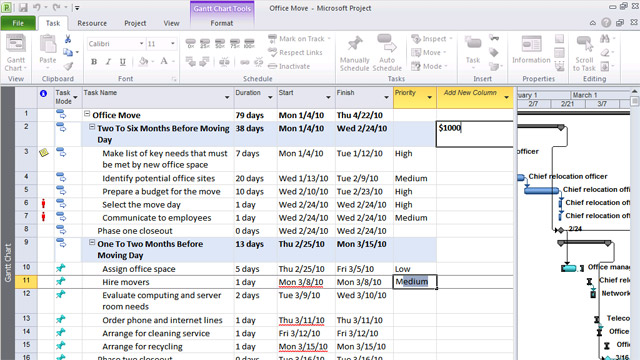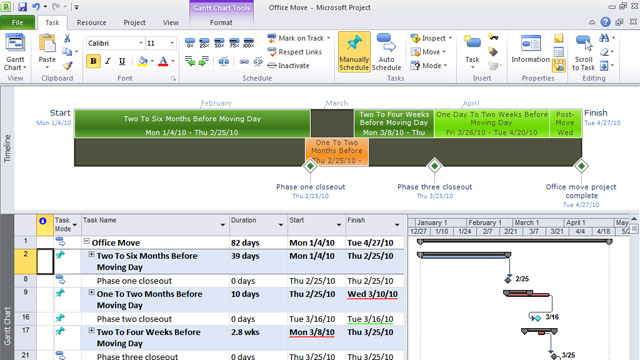Project Professional 2010:
What’s New—Top Features

Microsoft® Project Professional 2010 is a project managers software that gives project managers a new and easier way to manage wide range of projects and programs. With all of the new updates and visual enhancements of Project Standard 2010, Project Professional 2010 delivers more with at-a-glance resource management and team collaboration tools using Microsoft® SharePoint® Foundation 2010, to successfully complete all types of projects. And, utilizing Project Professional 2010, you and your organization can realize the results of unified project and portfolio management by adding Microsoft Project Server 2010. Download What’s New.
Microsoft Fluent User Interface

Work more efficiently with the simple and intuitive Microsoft Fluent user interface—new graphical menus and a familiar experience provide the tools you need to plan and manage your project.
Task-oriented tabs and contextual menu groupings reveal powerful features, making it easier to get started and realize results.
Learn about features and rich formatting controls quickly with descriptive tooltips and drop-down galleries.
Simply be more productive by choosing your own menu options, quick access toolbar settings and setting defaults.
Save to XPS or PDF. Quickly share, print, and publish project information from one location using the new Microsoft® Office Backstage™ view.
Excel-Like Flexibility & Ease

Enhanced copy and paste makes it easy to share information effectively with other Microsoft Office applications while retaining formatting.
Add columns dynamically by entering data without having to first select the data type.
Simplify data entry with auto-complete which displays a list of previously used values to select from.
Automatic text wrap eliminates extra formatting steps by adjusting row height to display full task names.
Quickly mine data and analyze results with easy access filtering for all columns.
Create emphasis with rich color options and text formatting to express ideas and solve problems in new ways.
User-Controlled Scheduling

Gain flexibility with user-controlled scheduling—manually schedule tasks with the information you have right now or choose to automatically schedule tasks with calculated dates and durations.
Be alerted to potential scheduling concerns with squiggly lines and choose how to manage potential problems.
Gain insight with the Task Inspector to recognize issues and take action early—solving problems before they occur.
Support rolling wave planning and easily create high level forecasts using manually scheduled top down summary tasks.
Identify gaps by comparing manually scheduled summary tasks with information rolled up from subtasks.
In Microsoft Project Professional 2010, you can simplify planning with inactive and activetasks to perform what-if analysis.
Timeline View

Simply create the ultimate graphical timeline to express your schedule and plan.
It's easier to see and share—drill into details and visually recognize differences with a clear view of tasks, milestones, and phases.
Reach your audience with new impact by quickly copying the timeline into an email, presentation, or any other document with formatting retained.
Team Planner

Visualize the right mix of resources and assignments with a simple and intuitive resource view.
Simply drag-and-drop to effectively plan tasks and optimize resources for your entire team and project.
Quickly identify unassigned or unscheduled tasks to proactively solve problems.
Simply hover over tasks to instantly view task-level details to plan with ease.
Be visually alerted to potential problems, choose to manually level resources as you work.
Automatically level over allocated resources on a task-by-task basis using Task Inspector to instantly resolve problems.
Connected Teams

Enhance team collaboration by sharing information more efficiently—simply save, print or publish in one easy-to-manage Microsoft® Office Backstage™ view.
Convert Microsoft® SharePoint® Foundation 2010 task lists to realize project schedules.
Publish your project plans to SharePoint® Foundation 2010 task lists so team members can update task status—automatically synchronize to receive updates directly into your project plans.
Save, share and manage—simply be more connected in the ways you expect with Project Professional 2010 and SharePoint® Foundation 2010.
Connect Project Professional 2010 with Microsoft Project Server 2010 and gain control across all types of work, improve project selection and strategic alignment, maximize resource utilization and visualize performance through powerful dashboards.
Top 10 Benefits
Microsoft® Project Professional 2010 delivers a project management system with powerful, visually enhanced ways to effectively manage a wide range of projects and programs. From meeting crucial deadlines to selecting the right resources and empowering your teams, Project Professional 2010 helps project management professionals by offering easier and more intuitive experiences to be more productive and realize amazing results.
Download the Top Benefits.
1. Familiar and intuitive.
The Ribbon makes finding and using your favorite tools simpler with new graphical menus and a familiar experience to help you easily create and manage projects. Tooltips and contextual guidance provide information and shortcuts so you can accomplish more in less time. In the new Microsoft® Office Backstage™ view, simply save, share, print, or publish your projects from one location.
2. Save time and effort.
Save time and effort with familiar and essential functions like text wrapping, filtering, auto-complete, scroll and zoom, and more. Insert new columns on the fly—data types are readily identified so that you can quickly and effectively organize and analyze details. Quickly share schedule details through enhanced copy-and-paste, and retain key formatting between Project 2010 and other Microsoft Office applications.
3. Flexible and powerful.
User-controlled scheduling puts you in control and brings together the flexibility and ease of use of a tool like Microsoft Excel® 2010 and the power of the Project 2010 scheduling engine. Create project schedules at the level of detail that’s right for your project. Work with summary data initially or shift to a more detailed approach when it’s convenient. Place notes as reminders of where additional schedule information is needed, or simply add information as it becomes available.
4. Easier to see and share.
With a completely new and visually enhanced timeline view, you’ll have a clearer view of tasks, milestones, and phases. Newly expanded color palettes and text effects help you make every timeline and plan look their best—and help you to swiftly see and share important dates and deliverables.
5. At-a-glance.
(Team Planner – Pro only)
See the right mix of people and resources: simply drag tasks to effectively plan work for your entire team and project. The new Team Planner view in Project Professional 2010 shows resources and work over time, to help you spot problems and resolve issues. New in Project 2010, the Task Inspector offers additional analysis and intuitive guidance to resolve scheduling conflicts derived from a task’s attributes and assigned resources, which you can choose to act upon or not.
6. Control and deliver.
Quickly compare budget versus actual versus forecasted values to measure an initiative's progress with the flexibility of setting multiple baselines. Create high-level time-phased budgets with user-defined categories for costs and labor. Validate budgets against bottom-up estimates built by using labor, material, and cost resources. Control project costs by comparing budgets to completed tasks and forecasted totals. Use built-in earned-value metrics for predictive analysis and integrated performance management.
7. Evaluate possibilities.
(Inactive Tasks – Pro only)
Often you'll need to evaluate scenarios and consider options when planning new projects or monitoring ongoing work. Using inactive tasks, new in Project Professional 2010, you can easily experiment with your project plan and perform what-if analysis. A simple toggle removes or inserts one or more tasks, along with their effect on the project schedule. Project 2010 also offers more built-in tools to help support what-if analysis and scenario comparison, including multiple-level undo and change highlighting.
8. Collaborate with others.
(Task Status Updates – Pro only)
Connect your teams by synchronizing with Microsoft SharePoint® Foundation 2010. Using Project Professional 2010, you can synchronize SharePoint Foundation 2010 and Project Professional 2010 project task status updates for you and your team members. You can also save your project files to SharePoint Foundation 2010 team sites to communicate plans and collaborate on progress.
9. Grow capabilities.
(Connect to Project Server 2010 – Pro only)
Realize the power of unified project and portfolio management by combining Project Professional 2010 with Microsoft Project Server 2010. Together, Project Professional 2010 and Project Server 2010 create the Microsoft Enterprise Project Management (EPM) Solution, and deliver end-to-end capabilities to help organizations prioritize investments and optimize resources, gain control of all types of work, and visualize performance by using powerful dashboards.
10. Enhance performance.
Use the 64-bit options of Project 2010 to enhance performance and support very large projects and programs. Project Standard 2010 and Project Professional 2010 are offered in 32-bit and 64-bit options to support a diverse range of project types and sizes. 64-bit options take advantage of the expanded memory and optimized capabilities of the latest processors and of the 64-bit versions of Windows 7 and Windows Vista. 64-bit Project Professional 2010 also offers enhanced performance and handles extremely large project files with ease when connected to Project Server 2010.
What’s New
 Microsoft® Project Server 2010 provides unified project and portfolio management to help organizations prioritize investments, align resources and execute projects efficiently and effectively. Download What’s New.
Microsoft® Project Server 2010 provides unified project and portfolio management to help organizations prioritize investments, align resources and execute projects efficiently and effectively. Download What’s New.What’s New in Project Server 2010
Microsoft Project Server 2010 brings together the business collaboration platform services of Microsoft® SharePoint Server 2010 with structured execution capabilities to provide flexible work management solutions. Project Server 2010 unifies project and portfolio management to help organizations align resources and investments with business priorities, gain control across all types of work, and visualize performance through powerful dashboards.
Unified Project & Portfolio Management (PPM)
In Project 2010, the best-of-breed portfolio management techniques of Microsoft Office Project Portfolio Server 2007 are included in Project Server 2010, providing a single server with end-to-end project and portfolio management (PPM) capabilities.
Familiar SharePoint user interface throughout the solution.
Common data store eliminating the need for the Project Server Gateway.
Intuitive and simplified administration.
Localized portfolio selection capabilities.
Comprehensive Application Programming Interface (API) including both project and portfolio capabilities.
Built on SharePoint Server 2010
Project Server 2010 is built on top of SharePoint Server 2010, bringing together the powerful business collaboration platform services and structured execution capabilities to provide flexible work management solutions. Gain additional value from the Microsoft platform.
Take advantage of the Business Intelligence platform to easily create reports and powerful dashboards.
Control document review and approval through workflow.
Enterprise search makes it easy to find people and effectively mine project data (resources, tasks, documents etc.).
Connect teams and enhance communication with wikis, blogs, discussion forums and My Sites.
Project Initiation & Business Case Development
Project Server 2010 provides a new demand management module to capture all work from simple tasks to complex projects and programs.
Develop and deploy effective governance workflows to manage project investments throughout their lifecycle and drive accountability and control.
Define Enterprise Project Types for all requests and associate with workflow, a project plan and a custom workspace template.
Standardize data collection through configurable business case forms. Capture project information, cost estimates, resource estimates, strategic alignment assessments and more.
Display relevant Enterprise Project Types for each line of business using departmental fields.
Portfolio Selection
Project Server 2010 helps organizations select project portfolios that align with their business strategy by providing techniques to prioritize competing requests, run optimization scenarios under varying budgetary constraints and maximize resource utilization across the planning horizon.
Business Strategy Prioritization
Objectively prioritize business drivers and drive consensus across the executive team.
Intuitive and visual interface for completing the business driver prioritization assessment.
Portfolio Prioritization and Optimization
Effectively prioritize projects from multiple dimensions – strategic value, financial value, and risk.
Select the optimal portfolio of projects while meeting budgetary and other constraints.
Enhanced optimization interface surfaces powerful analytical views (e.g. Efficient Frontier) to improve decision making.
Better understand trade-offs with Force In/Out descriptive values.
Compare optimization scenarios side by side with snapshot scorecard.
Capacity Planning
Gain insight into generic resource demand and availability across the planning horizon.
Reschedule projects within the horizon to maximize resource utilization while adhering to schedule dependencies.
Model headcount decisions and compare scenarios.
Web-Based Project Editing
Project Server 2010 brings the power of Project Professional 2010 to the browser with Web-based Project Editing.
Easily build schedules online and conveniently make simple project edits from anywhere.
Gain flexibility with user controlled scheduling – manually schedule tasks with the information you have right now or automatically schedule tasks to have Project calculate durations and dates.
Create projects with more than 100 tasks, assign multiple resources, and easily define task hierarchy and dependencies.
Gain insight with change highlighting and multi-level undo.
Fluent™ User Interface
Microsoft Project 2010 delivers a consistent experience across Project Standard 2010, Project Professional 2010 and Project Server 2010 through the Fluent user interface.
Work more efficiently with the simple and intuitive Ribbon, so the tools you need to plan and manage your project are always at your fingertips.
Task oriented tabs and context sensitive menu groupings make finding and performing activities easier.
Task oriented tabs and context sensitive menu groupings make finding and performing activities easier.
Time Reporting Enhancements
Save time and unify task status updates and timesheet submissions by enabling Single Entry Mode.
Flexible and consistent interface enhances the time reporting experience.
Conveniently approve timesheet and task status updates through the consolidated Approval Center.
Simply delegate approvals with enhanced user delegation.
Exchange Server Integration
Choose to receive and update your project task status in Microsoft® Office Outlook.
Project tasks are shown as Outlook tasks grouped by project name. No Outlook add-in required.
Stay connected with notifications and updates through Outlook and Outlook Web App.
Enhanced Reporting and Business Intelligence (BI)
Experience the strength and depth of Microsoft Business Intelligence platform. Gain transparency and control with Excel Services, PerformancePoint Services, Visio Services, PowerPivot for Excel 2010 andSQL Reporting Services.
Get started quickly with predefined best practice and localized report templates in the new Business Intelligence Center.
Intuitively customize reports in a familiar Excel editor and publish through Excel Services.
Simply create powerful audience-based dashboards to effectively monitor portfolio performance.
Satisfy line of business reporting requirements with Departmental Cubes. Allow decision makers to focus on their data, eliminate unnecessary clutter and ensure faster cube build times.
Simplified Administration
Project Permissions – Empower project managers to control who can view or edit their projects with Project Permissions.
User Delegation – Enhanced delegation enables users to easily specify colleagues to act as their delegate when on vacation, without assistance from the administrator.
Departmental Fields – Provide a level of autonomy while maintaining enterprise standardization and control. With Departmental Fields administrators can associate Enterprise Project Types, Resources and Custom Fields to specific departments, eliminating unnecessary clutter and allowing departments to focus on their data.
Centralized Administration – One stop administration console for managing both project and portfolio management capabilities.
Administer Reporting Cubes – Enhanced administration interface for displaying the status and managing available cubes. Quickly take action and intuitively add, edit, delete, copy and refresh cubes.
Extend Interoperability
Integration with related Microsoft technologies provides a familiar and connected work management platform. Empower teams to work in their preferred productivity tools and provide status updates toproject stakeholders with minimal effort and administrative overhead.
Microsoft® Exchange Server – Conveniently receive and update your project tasks in Outlook or Outlook Web App.
Microsoft® Visual Studio Team Foundation Server – Seamlessly connect the worlds of application development and project and portfolio management.
SharePoint Server Sync – Effortlessly improve productivity with bidirectional status updates between Project Professional 2010 and SharePoint.
Top 10 Benefits
Microsoft Project Server 2010 is built on Microsoft SharePoint® Server 2010, and brings together powerful business collaboration platform services with structured execution capabilities to provide flexible work management solutions. Project Server 2010 unifies project and portfolio management to help organizations align resources and investments with strategic priorities, gain control across all types of work, and visualize performance by using powerful dashboards.
Download the Top Benefits.
1. Unified project and portfolio management.
The best-in-class portfolio management techniques available in Microsoft Office Project Portfolio Server 2007 are incorporated into Project Server 2010, providing a single server with an intuitive user interface that offers the right tools to support the entire project life cycle. By combining top-down portfolio management techniques with bottom-up project management capabilities, Project Server 2010 helps organizations identify and select optimal portfolios, and successfully deliver the projects to realize results.
2. Drive accountability and control with governance workflow.
Project Server 2010 workflow capabilities help organizations define the right governance processes to effectively control all types of work—project and operational—throughout the work life cycle. Establishing checkpoints within the process and identifying individuals with the appropriate approval authority helps drive accountability, increases awareness, and provides an auditable record of all investment decisions. The new Proposal Status Page helps the Project Management Office (PMO) effectively communicate the governance processes and educate employees to drive adoption, satisfaction, and compliance.
3. Standardize and streamline project initiation.
Project Server 2010 provides a one-stop-shopping demand management portal to help organizations streamline and standardize the initiation process for all types of work. Centralizing project and operational activities in a central system provides organizations with visibility across all requests and in-flight initiatives, so it is easy to eliminate duplicate requests and quickly assess the impact on available resources. The flexibility of Project Server 2010 helps the PMO provide departments with a level of autonomy, while standardizing the collection of data to facilitate enterprise reporting.
4. Select the right portfolios that align with strategy.
Gone are the days when projects are funded on a first-come, first-served basis. ProjectServer 2010 includes best-practice portfolio selection techniques that provide ahandshake between value optimization—that is, alignment with strategy—and resourceutilization, to help organizations adopt a more rational rather than emotional approachto investment selection. The new portfolio management and analytical capabilities helpexecutives do more with less and objectively demonstrate the investment alignmentwith strategic priorities.
a. Effectively prioritize and communicate business strategy.
Project Server 2010 helps executives break down their strategy into actionable, measurable, and discrete business drivers. The intuitive pairwise assessment helps to ensure that organizations objectively prioritize business drivers, drive executive consensus, and derive a relative score that is used to measure the strategic contribution of competing requests. Consolidating and prioritizing business drivers within Project Server 2010 helps to communicate the strategy in actionable terms, and provide a blueprint that can be understood and implemented by departmental managers.
b. Run what-if analyses under varying constraints.
Project Server 2010 helps organizations prioritize and assess projects from multiple dimensions—strategic value, financial value, risk—to provide objective, apples-to-apples comparisons. The intuitive Cost Constraint Analysis view helps analysts quickly model varying budget constraints and use a sophisticated optimization algorithm to recommend the project portfolio that best aligns with the business strategy. The Efficient Frontier, Strategic Alignment, and Compare Scenario views provide powerful insights that help executives identify tradeoffs, and evaluate and refine portfolio selection.
c. Proactively reschedule projects to maximize resource utilization.
The new capacity planning capability in Project Server 2010 helps analysts proactively assess the impact of proposed portfolio on the resource pool, and model scenarios to enhance utilization across the planning horizon. The powerful Resource Constraint Analysis view provides a holistic portal to help organizations visualize resource shortfalls and underutilization, adjust project start dates to better utilize available employees, and model headcount decisions to identify optimal hiring strategies.
5. Easily build Web-based project schedules.
Project Server 2010 empowers a mobile workforce by bringing the power of Microsoft Project Professional 2010 to the browser with Web-based project scheduling. Project managers can now take advantage of powerful diagnostic capabilities, such as Change Highlighting and Multi-Level Undo without first opening Project Professional 2010. Web-based scheduling provides occasional and certified project managers with the flexibility to quickly build simple and complex schedules online, and conveniently edit the plan from any location over the Internet.
6. Intuitively submit time and task updates.
Project Server 2010 provides organizations with the flexibility they need to centralize time capture, streamline processes, automate task management, and increase the accuracy of project forecasting. Time reporting capabilities have been further enhanced in Project Server 2010 to provide a new Single Entry Mode to unify time and task status updates. The Web-based user interface for timesheet entry and task management has been standardized to speed learning and enhance user experience. Project Server 2010 connects with Microsoft Exchange Server 2010 to ensure that team members can conveniently receive and update their project tasks in Microsoft Outlook® 2010 and Outlook Web App.
7. Gain visibility and control through reports and dashboards.
Project Server 2010 provides a powerful reporting infrastructure coupled with flexible Business Intelligence tools to help ensure that organizations proactively gain visibility across their project portfolios, that they can react quickly, and can generate custom reports. Project Server 2010 uses the Microsoft Business Intelligence platform, including Excel® Services, PerformancePoint® Services, Visio® Services, PowerPivot for Excel, SQL Reporting Services, and more, to provide organizations with a comprehensive solution that will grow with their reporting needs. The solution provides nontechnical resources with familiar tools to easily create reports and configure powerful audience-based dashboards, while providing technical resources with more sophisticated capabilities to create complex views.
8. Simplified administration and flexibility.
Project Server 2010 is extremely flexible and can be quickly configured to meet an organization’s unique requirements and business processes. Project Server 2010 simplifies administration through an improved console that consolidates both project and portfolio management capabilities. New features including User Delegation and Project Permissions reduce the burden on the administrator by empowering user action. Project Server 2010 helps to ensure that PMOs and administrators can spend less time managing the system and focus more on project and portfolio delivery and performance.
9. Gain additional value from the Microsoft platform.
Project Server 2010 connects with related Microsoft technologies, such as SharePoint Server 2010, Microsoft Office 2010, and Exchange Server 2010, to provide a powerful and familiar work management platform. This helps to ensure that team members can choose their preferred productivity tools to easily receive tasks and provide status updates to project stakeholders with minimal effort and administrative overhead. This flexibility helps drive productivity and helps to ensure that project managers and PMOs can effectively gather the required data to drive enterprise reporting and resource management.
10. Extensible and programmable platform.
Project Server 2010 provides an open, extensible, and programmable platform to help ensure that organizations can easily develop custom solutions and effectively integrate with line-of business systems. Because Project Server 2010 is built on SharePoint Server 2010, developers can take advantage of a consistent and robust platform to rapidly build and deploy solutions using familiar tools and services, including Windows Communication Foundation, Business Connectivity Services, Microsoft Visual Studio® 2010, and Microsoft SharePoint Designer 2010.
To know more on Microsoft project, please click here.
PCO Subject Expert review (In Process)
PCO Members Review
PCO members wishing to share and display their views, please click here